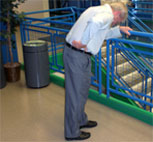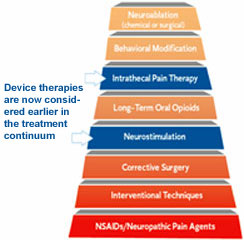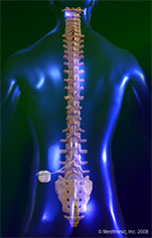 The
World Health Organization has defined pain as “an unpleasant sensory
or emotional experience associated with actual or potential tissue
damage, or described in terms of such damage”. The National Center
for Health Statistics Report in 2006 revealed that more than
one-quarter of Americans (26%) age 20 years and over - or, an
estimated 76.5 million Americans - report that they have had a
problem with pain of any sort that persisted for more than 24 hours
in duration (1). Of the 26% of Americans who suffer from pain, 42%
of these individuals have experienced pain for longer than one year.
The
World Health Organization has defined pain as “an unpleasant sensory
or emotional experience associated with actual or potential tissue
damage, or described in terms of such damage”. The National Center
for Health Statistics Report in 2006 revealed that more than
one-quarter of Americans (26%) age 20 years and over - or, an
estimated 76.5 million Americans - report that they have had a
problem with pain of any sort that persisted for more than 24 hours
in duration (1). Of the 26% of Americans who suffer from pain, 42%
of these individuals have experienced pain for longer than one year.
The U.S. National Center for Health Statistics defines chronic pain
as pain that lasts longer than 3 months. However some experts define
it as lasting longer than 6 or 12 months (2). All the same, chronic
pain is a devastating condition which affects the lives of a
significant portion of the population. Conditions which are often
associated with the worst form of chronic pain can include: post
surgical chronic back pain, failed back syndrome, radicular pain
syndrome, discogenic syndrome, postlaminectomy pain, degenerative
disc disease, peripheral causalgia, epidural fibrosis, complex
regional pain syndrome, reflex sympathetic dystrophy or causalgia
and arachnoiditis.
 Patients with chronic pain often seek treatment options from a
variety of healthcare providers in various disciplines. Often times
a trial of oral pain medications are first utilized in an attempt to
control the pain. If unsuccessful, other treatment approaches can
also be utilized including corticosteriod injections, nerve blocks,
physical therapy, chiropractic care, device therapies and surgery.
Most recently, pain management specialists are now considering
device therapies earlier in the treatment continuum (3).
Patients with chronic pain often seek treatment options from a
variety of healthcare providers in various disciplines. Often times
a trial of oral pain medications are first utilized in an attempt to
control the pain. If unsuccessful, other treatment approaches can
also be utilized including corticosteriod injections, nerve blocks,
physical therapy, chiropractic care, device therapies and surgery.
Most recently, pain management specialists are now considering
device therapies earlier in the treatment continuum (3).
 One such device that is currently being utilized by many pain
management specialists is the use of a neurostimulator.
Neurostimulation or spinal cord stimulation therapy involves the use
of an external pulse generator to deliver small electrical signals
via percutaneous leads which are implanted into the epidural space
on the dorsal aspect of the spinal cord at the appropriate nerve
root level(s) (4). These signals assist with inhibiting pain signals
before they reach the brain and replaces them with a tingling
sensation that covers the specific areas where pain was felt. The
electrical current from the lead which generates paresthesias can be
adjusted in intensity and location to achieve the best pain
coverage. Patients can than adjust stimulation to meet pain
management needs.
One such device that is currently being utilized by many pain
management specialists is the use of a neurostimulator.
Neurostimulation or spinal cord stimulation therapy involves the use
of an external pulse generator to deliver small electrical signals
via percutaneous leads which are implanted into the epidural space
on the dorsal aspect of the spinal cord at the appropriate nerve
root level(s) (4). These signals assist with inhibiting pain signals
before they reach the brain and replaces them with a tingling
sensation that covers the specific areas where pain was felt. The
electrical current from the lead which generates paresthesias can be
adjusted in intensity and location to achieve the best pain
coverage. Patients can than adjust stimulation to meet pain
management needs.
Various studies have been conducted which have shown positive
results with the use of neurostimulation therapy. A study by Kumar
et al (5) performed a multicenter randomized controlled trial for
spinal cord stimulation for chronic pain associated with failed back
surgery syndrome against conventional medical management over 24
months. The study revealed that after 24 months of neurostimulation
treatment, selected failed back surgery syndrome patients reported
sustained pain relief, clinically important improvements in
functional capacity and health-related quality of life, and
satisfaction with treatment. Another study by North et al (6)
compared neurostimulation with lumbosacral spine surgery for chronic
pain. The study concluded neurostimulation is more effective than
reoperation as a treatment for persistent radicular pain after
lumbosacral spine surgery, and in the great majority of patients, it
obviates the need for reoperation.
Some added benefits of neurostimulation therapy includes (4):
• An effective method of pain control for many patients
• Reduces or eliminates pain medications
• Non-destructive and less invasive than surgical alternatives
• Reversible – can be discontinued or surgically removed
• Systems reprogrammable without surgery
• Trial helps assess patient response
• Patient control within physician-set limits
Meanwhile, there are some risks which are associated with neurostimulation
therapy as well. These risks includes (4):
• Lead migration resulting in loss of pain relief
• Intermittent or uncomfortable stimulation
• Stimulation in the wrong location
• Neurological damage during procedure
• Risk of infection at implantation
Once a patient has been able to better manage his or her pain with
the neurostimulator, additional physical rehabilitation may be
required to assist the patient with improving strength, ROM,
posture, gait and function. In physical therapy, when working with
patients who have had a neurostimulator device implanted, modalities
such as diathermy, electrical stimulation and ultrasound to or
around the area should be avoided. Therapists should also ensure
that patients avoid activities and exercises that may put undue
stress on the implanted neurostimulation system components. With
more efficient pain management, the patient should now be presented
with the opportunity for better participation in physical therapy
with the primary goal of of achieving additional functional outcomes.
Last revised: May 18, 2010
By Kostandinos Tsoulfas, MD & Chai Rasavong, MPT
References
1) http://www.painfoundation.org/newsroom/reporter-resources/pain-facts-figures.html
2) Main, CJ; Spanswick, CC (2001). Pain management: an
interdisciplinary approach. Elsevier. p. 93.
3) Stamatos JM, et al. Live Your Life Pain Free, October 2005. Based
on the interventional pain management experience of Dr. John
Stamatos
4) http://professional.medtronic.com/interventions/spinal-cord-stimulation/overview/index.htm
5) Kumar K, Taylor RS, et al. The effects of spinal cord stimulation
in neuropathic pain are sustained: a 24-month follow-up of the
prospective randomized controlled multicenter trial of the
effectiveness of spinal cord stimulation. Neurosurgery
2008;63(4):762-70.
6) North RB, Kidd DH, et al. Spinal cord stimulation versus repeated
lumbosacral spine surgery for chronic pain: a randomized, controlled
trial. Neurosurgery 2005;56(1):98-1067.


 The
World Health Organization has defined pain as “an unpleasant sensory
or emotional experience associated with actual or potential tissue
damage, or described in terms of such damage”. The National Center
for Health Statistics Report in 2006 revealed that more than
one-quarter of Americans (26%) age 20 years and over - or, an
estimated 76.5 million Americans - report that they have had a
problem with pain of any sort that persisted for more than 24 hours
in duration (1). Of the 26% of Americans who suffer from pain, 42%
of these individuals have experienced pain for longer than one year.
The
World Health Organization has defined pain as “an unpleasant sensory
or emotional experience associated with actual or potential tissue
damage, or described in terms of such damage”. The National Center
for Health Statistics Report in 2006 revealed that more than
one-quarter of Americans (26%) age 20 years and over - or, an
estimated 76.5 million Americans - report that they have had a
problem with pain of any sort that persisted for more than 24 hours
in duration (1). Of the 26% of Americans who suffer from pain, 42%
of these individuals have experienced pain for longer than one year.
 Patients with chronic pain often seek treatment options from a
variety of healthcare providers in various disciplines. Often times
a trial of oral pain medications are first utilized in an attempt to
control the pain. If unsuccessful, other treatment approaches can
also be utilized including corticosteriod injections, nerve blocks,
physical therapy, chiropractic care, device therapies and surgery.
Most recently, pain management specialists are now considering
device therapies earlier in the treatment continuum (3).
Patients with chronic pain often seek treatment options from a
variety of healthcare providers in various disciplines. Often times
a trial of oral pain medications are first utilized in an attempt to
control the pain. If unsuccessful, other treatment approaches can
also be utilized including corticosteriod injections, nerve blocks,
physical therapy, chiropractic care, device therapies and surgery.
Most recently, pain management specialists are now considering
device therapies earlier in the treatment continuum (3).




